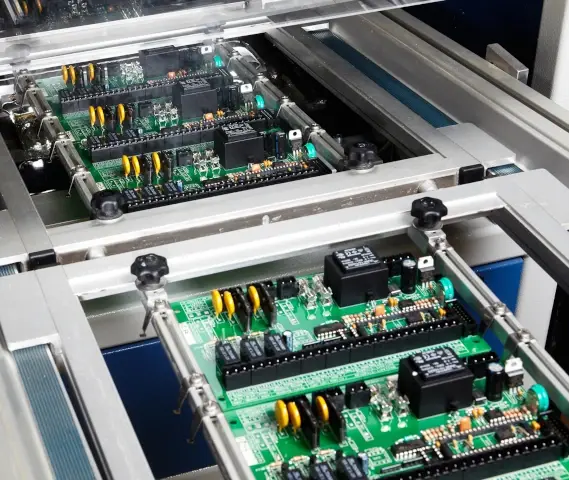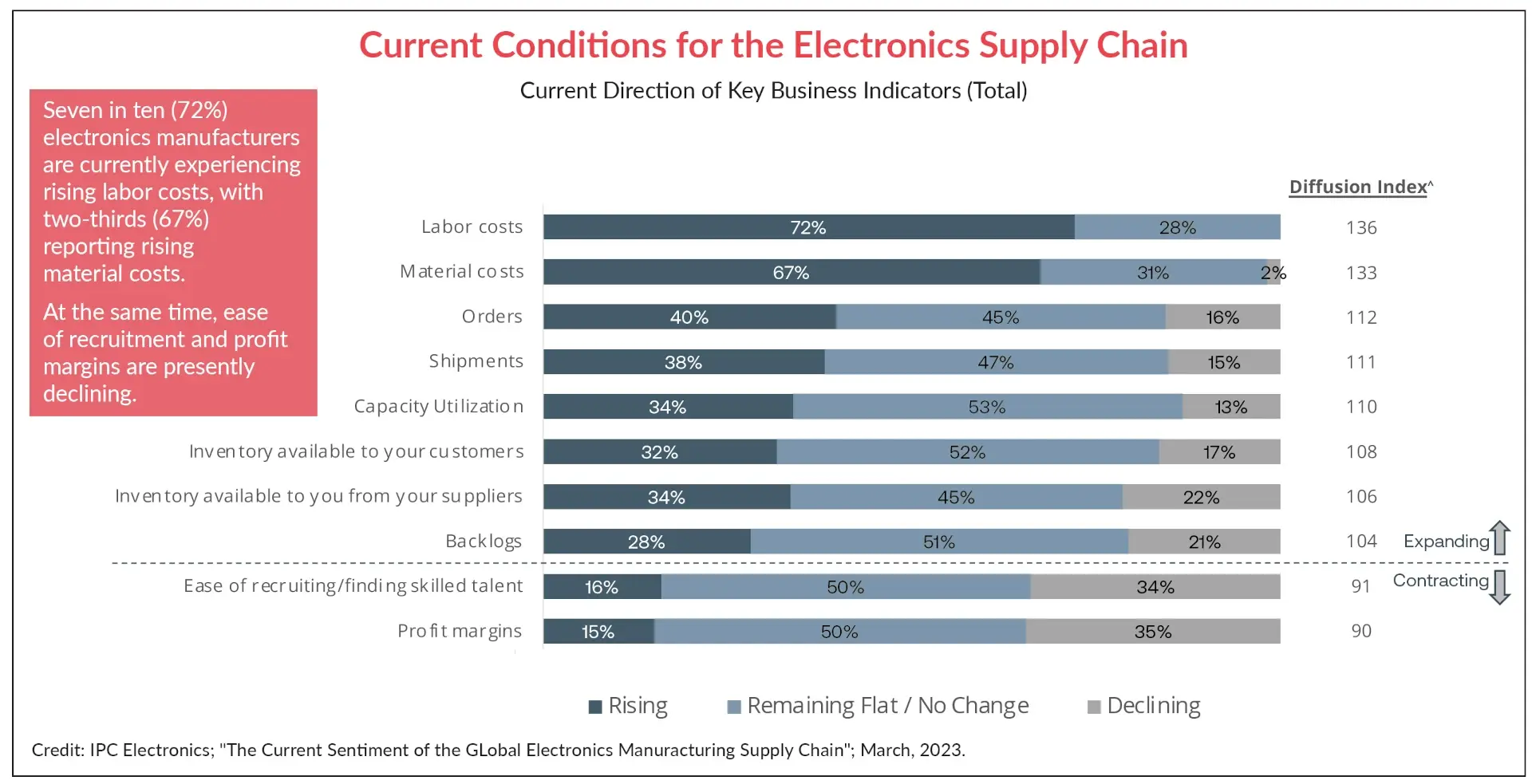Macro Trends Reshaping the Electronics Manufacturing Landscape

The electronics manufacturing industry is amid a transformative evolution driven by burgeoning demand, labor market dynamics, and strategic pricing maneuvers. Amid this metamorphosis, Electronics Manufacturing Services (EMS) shipments have surged, laying the foundation for opportunities and challenges for industry leaders. Let’s explore the macro trends shaping the PCBA manufacturing industry’s trajectory and delve into the implications of this transformation.
Catching the Wave of Enduring Demand

The electronics manufacturing industry has showcased remarkable resilience in the face of economic uncertainties. North American EMS shipments, for instance, grew by 9.4 percent YoY in May 2022, showcasing an impressive book-to-bill ratio of 1.35 (a ratio greater than 1.00 indicates that current demand exceeds supply) . Moreover, the upward trajectory continued through October 2022, with a 14.9 percent YoY increase .
The enduring demand for electronic products and the rapid adoption of digitalization across various sectors drive the industry’s growth. Consequently, the EMS market, valued globally at $504 billion in 2022, is expected to reach $797.94 billion by 2029, with a compound annual growth rate (CAGR) of 6.8 percent.
However, this anticipated expansion in the global market should be approached cautiously, given the pessimistic global economic forecast recently released by the International Monetary Fund. Global growth is predicted to decelerate to below three percent over the next five years. While growth within the industry is still expected, electronics manufacturing expansion may be confined to specific regions or sectors rather than being experienced universally.
Navigating Regional Disparities

The trajectory of the industry is marked by significant regional variations. For instance, growth in the EMS market in North America has outpaced other regions for the last several years. These regional differences extend to material costs, labor markets, and consumer preferences.
In 2022, the North American EMS market surpassed $90 billion, propelled by an increasing need for cost-effective but flexible manufacturing, outsourcing trends, and increasing demand for high-end customized electronics. Furthermore, investments in research and development for high-end automobiles and aerospace have boosted the region’s EMS demand.
Checkpoint
The reshoring trend is anticipated to sustain–if not bolster– demand for North American manufacturing services even as [traditional manufacturing powerhouses like China experience potential slowdowns.

Legislation such as the CHIPS Act has also contributed to the increase in domestic manufacturing, as has the increasing demand for reliable manufacturing that is not affected by black swan events or geopolitical factors.
The reshoring trend that began as a response to supply chain disruptions caused by the COVID-19 pandemic and political unrest is anticipated to sustain–if not bolster–demand for North American manufacturing services. Experts project this trend will persist even as traditional manufacturing powerhouses like China experience potential slowdowns.
This shift aligns with an increased emphasis on supply chain resilience, national security, and job creation within the tech industry. With companies repatriating their manufacturing capabilities, the North American EMS market is expected to remain robust and possibly redefine the global EMS landscape.
Finding Skilled Talent

The industry’s labor market presents a complex picture. The recruitment landscape has experienced improvement, with more companies reporting success in attracting skilled talent. However, the demand for specialized expertise is intensifying, driven by the rapid evolution of technology.
Official estimates suggest that across industries in the US, there will be a shortfall of 300,000 engineers and 90,000 skilled technicians by 2030 . China, too, faces an ongoing labor shortage as its workforce ages. This tech talent shortage in the electronics manufacturing sector further highlights companies’ challenges in finding and attracting qualified professionals.
Domestic labor challenges will require a multifaceted approach, such as upskilling the current workforce to bridge skills gaps, collaborating with technical schools to cultivate future talent, embracing automation, and fostering a diverse workforce to draw from a wider pool of skilled candidates. Using such innovative strategies, companies will be able to overcome challenges and secure the talent they need.
Strategic Pricing and Revenue Dynamics
Pricing strategies are at the forefront of the industry’s decision-making. Approximately 58 percent of electronics companies expect to raise prices in 2023, with an average increase of 8 percent. However, the relationship between price hikes and revenue growth remains uncertain, as numerous factors can influence this correlation.
Although there has been a surge in orders and shipments, the rapid escalation in labor and material costs is outpacing the potential profit gains. This poses a significant challenge for companies in the sector, as they must find ways to create value and differentiation in a highly competitive market.

To drive revenue growth, electronics companies should consider exploring innovative solutions, enhancing product features, and adopting customer-centric approaches. These strategies will allow them to not only offer differentiated products and services but also adapt to the changing market conditions. By focusing on innovation and customer needs, electronics companies can maintain a competitive edge in the industry without solely relying on price increases as a long-term solution.
Future Opportunities and Challenges
In light of these developments and conflicting trends, electronics businesses should remain aware of potential shifts in the EMS manufacturing industry at large. As more companies reshore, the domestic market may become increasingly competitive and crowded. Backlogs are already on the rise at some domestic manufacturers, according to IPC. Stay abreast of competitors’ strategies and overall market trends to maintain a competitive advantage.
Moreover, businesses should diligently monitor supply chain trends to measure changes in component availability, pricing, and available manufacturing capacity. By proactively monitoring these trends, companies can adjust strategies accordingly to mitigate adverse effects.

Further, companies can seize opportunities by focusing on value creation through innovative solutions and customer-centric offerings to differentiate themselves in an evolving marketplace.
Finally, cyber threats and data security concerns are increasingly relevant as digitalization advances. As a result, electronics companies must prioritize robust cybersecurity measures to protect sensitive information and maintain consumer trust.
Conclusion

As the electronics manufacturing landscape evolves, industry leaders must stay attuned to macro trends, labor market dynamics, strategic pricing, and regional disparities. By embracing a global perspective and proactively addressing challenges, electronics companies can capitalize on opportunities and confidently navigate the transformative tide. In this rapidly changing environment, adaptability and foresight will be vital to riding the crest of this wave of change and emerging as successful, forward-looking industry leaders.
Related Topics
Preparing for Potential Supply Chain Disruptions During Lunar New Year
This blog discusses on how to prepare for unexpected events for global supply chains such as the dockworker strike in preparation for Lunar New Year.
Mapping Out a PCBA Supply Chain Strategy in Five Moves
Companies should create unique vendor relationships with numerous international suppliers due to the necessity of having to source components globally.
MacroFab’s Modern Approach to Strategic Sourcing
Many Contract Manufacturers (CMs) and Original Equipment Manufacturers (OEMs) have some sort of procurement team. So what makes MacroFab so different?
Eliminate Overseas Risks with a Trusted Local Partner
Reshore with MacroFabAbout MacroFab
MacroFab offers comprehensive manufacturing solutions, from your smallest prototyping orders to your largest production needs. Our factory network locations are strategically located across North America, ensuring that we have the flexibility to provide capacity when and where you need it most.
Experience the future of EMS manufacturing with our state-of-the-art technology platform and cutting-edge digital supply chain solutions. At MacroFab, we ensure that your electronics are produced faster, more efficiently, and with fewer logistic problems than ever before.
Take advantage of AI-enabled sourcing opportunities and employ expert teams who are connected through a user-friendly technology platform. Discover how streamlined electronics manufacturing can benefit your business by contacting us today.